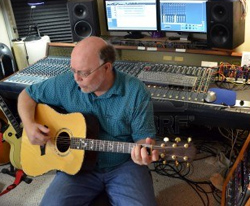There are as many ways to mic an acoustic guitar as there are engineers in the world.
I want to show you why you should consider stereo-miking acoustic guitars (that is, using two microphones on the guitar instead of just one), and then offer reasons not to do it.
A lot of engineers will throw a single mic on an acoustic guitar, point it at the 12th fret, and hit record.
While there’s nothing wrong with this, I think a lot of people are missing out on some very cool guitar tones.
With that in mind, here are three reasons to stereo-mic an acoustic guitar.
1. It adds width to your guitar-vocal demos (or solo acoustic guitar).
If you’ve recorded a basic guitar-vocal demo using one mic on guitar and one on vocal, you’ll notice that while the recording may sound great, it can be very narrow, very mono. You can play around with reverb plugins to add some space and width, but acoustic guitar rarely sounds all that good (or natural) through a reverb.
One technique a lot of engineers will use is to slightly pan the mono guitar track to the left or right, creating some separation between the guitarist and the vocalist. This may help a bit, but it still comes off sounding very mono.
There’s nothing wrong with mono. But having that extra width may make your demos stand out from the rest of the mono crowd.
2. It captures the entire instrument.
If you were to mic up a big Steinway grand piano, would you use one microphone? Of course not. It’s a big instrument, and it would take at least two if not four or six microphones to adequately capture the sound.
The same holds true with acoustic guitar. The tone of the guitar is spread out over the entire instrument. If you stick a microphone three inches from the 12th fret, you may get a nice sound, but you’ll only be taking a snapshot of a small portion of the guitar’s overall sound. You won’t be capturing the sound of the guitar as it was meant to be heard – as a whole.
As you may know, if you place a microphone along the neck, you’ll get a lot of high-end. If you place the mic down below the bridge, you’ll get a lot of bottom end. Each one by itself gives a bit of a misrepresentation of the guitar as a whole, but when combined you get a very full-sounding acoustic guitar track.
3. It allows you to place the mics closer to the instrument, picking up less noise.
Noise is one of the biggest issues we face. While it would be nice to place the microphone four feet away from the guitar, that’s simply not possible in many situations. AC noise, computer noise, neighbor noise, traffic noise — they all come into play.
The beauty of stereo-miking the acoustic guitar is that you can place the microphones right up on the instrument.
For example, this past weekend I spent a lot of time recording acoustic guitar. I had one microphone above the bridge, angled inward. The second microphone I placed at around the 6th fret, angled inward. Both mics were roughly 4 inches from the guitar.
Because the mics were so close to the guitar, they picked up more of the guitar’s sound and less of the room noise. Also, because I had two microphones, I didn’t sacrifice tone, since I was picking up both the lows (with the first mic) and the highs (with the second mic).
The end result was a huge acoustic guitar sound with minimal noise.
Stereo-miking acoustic guitars isn’t for everyone, nor is it for every guitar or song or recording. However, if you’ve not given it much thought, try it next time you record acoustic.
Audio Samples
I’ve got four samples for your listening enjoyment. They’re mono and stereo recordings of the same performance. Listen to the mono version first, then listen to the stereo.
With the mono tracks, you’re listening to the single microphone along the neck. It doesn’t sound bad at all, but then when you add the second microphone, a fullness enters the mix. These are dry tracks with a bit of EQ, but no other effects or compression. (And they’re all 16-bit WAV files.)





















